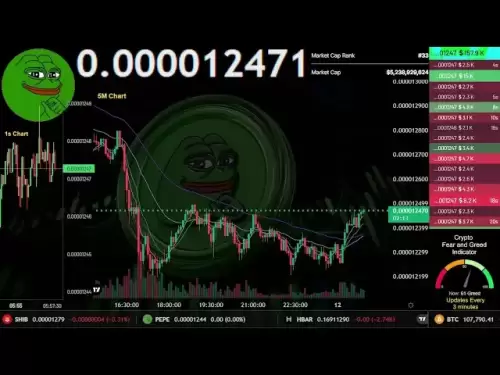-
 Bitcoin
Bitcoin $107,631.9817
-1.73% -
 Ethereum
Ethereum $2,739.1787
-4.61% -
 Tether USDt
Tether USDt $1.0000
-0.01% -
 XRP
XRP $2.2427
-3.30% -
 BNB
BNB $664.0527
-0.73% -
 Solana
Solana $158.0902
-5.38% -
 USDC
USDC $0.9998
-0.01% -
 Dogecoin
Dogecoin $0.1876
-7.78% -
 TRON
TRON $0.2753
-3.21% -
 Cardano
Cardano $0.6820
-5.55% -
 Hyperliquid
Hyperliquid $43.0171
-0.38% -
 Sui
Sui $3.3308
-4.87% -
 Chainlink
Chainlink $14.3431
-7.89% -
 Avalanche
Avalanche $21.0266
-6.48% -
 Bitcoin Cash
Bitcoin Cash $437.7657
-1.56% -
 Stellar
Stellar $0.2746
-2.52% -
 UNUS SED LEO
UNUS SED LEO $8.8665
-1.96% -
 Toncoin
Toncoin $3.1885
-3.37% -
 Shiba Inu
Shiba Inu $0.0...01260
-6.84% -
 Hedera
Hedera $0.1686
-4.93% -
 Litecoin
Litecoin $88.8406
-5.16% -
 Polkadot
Polkadot $4.0542
-6.28% -
 Monero
Monero $322.5806
-4.20% -
 Ethena USDe
Ethena USDe $1.0004
-0.02% -
 Bitget Token
Bitget Token $4.7089
-3.10% -
 Dai
Dai $0.9998
-0.01% -
 Pepe
Pepe $0.0...01206
-9.06% -
 Uniswap
Uniswap $7.8694
-5.20% -
 Pi
Pi $0.6232
-2.68% -
 Aave
Aave $301.3815
-3.83%
How to view the callback to the key moving average with reduced volume? How to grasp the rebound signal?
Key moving averages like 50-day, 100-day, and 200-day help identify trends and trading opportunities in crypto; callbacks with reduced volume signal potential rebounds.
Jun 10, 2025 at 12:57 am
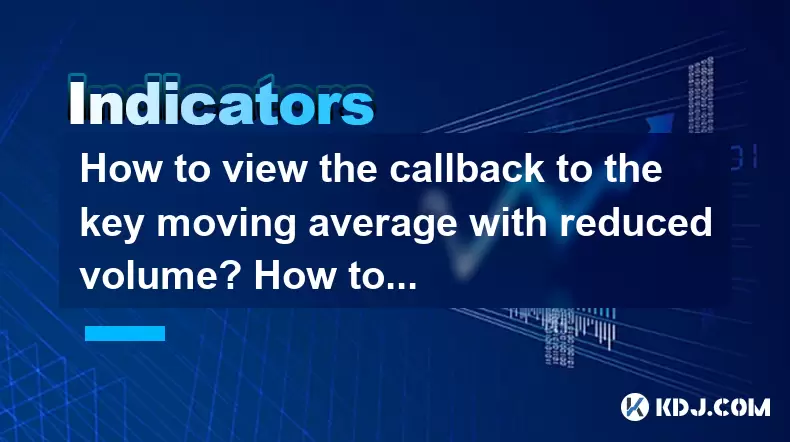
Understanding Key Moving Averages in Cryptocurrency Trading
In the world of cryptocurrency trading, key moving averages play a crucial role in technical analysis. They help traders identify trends and potential reversal points in the market. The most commonly used moving averages include the 50-day, 100-day, and 200-day moving averages. When a cryptocurrency's price approaches or "callbacks" to these moving averages, it can signal potential trading opportunities.
What is a Callback to the Key Moving Average?
A callback to the key moving average occurs when the price of a cryptocurrency retraces back to one of its key moving averages after a period of upward or downward movement. This phenomenon is often seen as a potential point of support or resistance, depending on the overall trend. For traders, understanding these callbacks is essential for making informed trading decisions.
The Role of Volume in Analyzing Callbacks
Volume is a critical factor in analyzing callbacks to key moving averages. When a callback occurs with reduced volume, it suggests that the price movement lacks strong participation from market participants. This can indicate a weaker signal, as the price may not have enough momentum to sustain a new trend. Conversely, a callback with high volume can be a more reliable signal of a potential trend change.
How to View the Callback to the Key Moving Average with Reduced Volume
To effectively view and analyze a callback to a key moving average with reduced volume, follow these steps:
Select a charting platform: Use a reliable cryptocurrency charting platform such as TradingView, Binance, or Coinbase Pro. These platforms offer detailed charts and volume indicators.
Choose the appropriate time frame: Depending on your trading style, select a time frame that aligns with your strategy. For short-term trading, use hourly or daily charts. For long-term analysis, weekly or monthly charts may be more suitable.
Add moving averages to your chart: Add the 50-day, 100-day, and 200-day moving averages to your chart. Most platforms allow you to customize these indicators easily.
Monitor price and volume: Observe the price as it approaches the key moving averages. Simultaneously, keep an eye on the volume indicator. If the volume decreases as the price callbacks to the moving average, it indicates a reduced volume scenario.
Analyze the context: Consider the overall market trend and any significant news or events that may impact the cryptocurrency's price. This context can help you better understand the significance of the callback.
Grasping the Rebound Signal
A rebound signal occurs when the price of a cryptocurrency bounces off a key moving average, especially with reduced volume. This can indicate a potential reversal or continuation of the current trend. To grasp this signal effectively, follow these steps:
Identify the callback: Confirm that the price has indeed reached one of the key moving averages.
Check the volume: Ensure that the volume is reduced during the callback. This can be a sign of a potential rebound.
Look for confirmation: Wait for the price to show a clear bounce off the moving average. This can be confirmed by a candlestick closing above the moving average after touching it.
Consider additional indicators: Use other technical indicators such as the Relative Strength Index (RSI) or the Moving Average Convergence Divergence (MACD) to confirm the rebound signal. For instance, if the RSI is oversold and starts to rise as the price rebounds, it can add confidence to the signal.
Evaluate the risk-reward ratio: Before entering a trade based on the rebound signal, assess the potential risk and reward. Ensure that the potential profit justifies the risk taken.
Practical Example of Identifying a Callback and Rebound Signal
To illustrate how to identify a callback to a key moving average with reduced volume and grasp the rebound signal, consider the following example:
Scenario: Bitcoin (BTC) is in an uptrend and has recently pulled back to its 50-day moving average.
Step 1: Open a daily chart of Bitcoin on TradingView and add the 50-day moving average to the chart.
Step 2: Observe that Bitcoin's price has touched the 50-day moving average at $40,000.
Step 3: Check the volume indicator and note that the volume has decreased significantly as Bitcoin approaches the 50-day moving average.
Step 4: Monitor the price closely. A few hours later, Bitcoin's price starts to rise again, and a bullish candlestick closes above the 50-day moving average.
Step 5: Confirm the rebound signal by checking additional indicators. The RSI, which was oversold at 30, begins to rise, indicating increasing momentum.
Step 6: Evaluate the risk-reward ratio. If Bitcoin rebounds to $45,000 from the current $40,000, the potential reward is $5,000. If the stop loss is set at $39,000, the risk is $1,000. The risk-reward ratio of 5:1 is favorable.
Technical Indicators to Enhance Analysis
In addition to moving averages and volume, other technical indicators can enhance your analysis of callbacks and rebound signals:
Relative Strength Index (RSI): The RSI helps identify overbought and oversold conditions. A rebound from a key moving average can be more reliable if the RSI is in oversold territory and starts to rise.
Moving Average Convergence Divergence (MACD): The MACD can signal potential trend changes. A bullish crossover on the MACD as the price rebounds from a key moving average can confirm the signal.
Bollinger Bands: Bollinger Bands can provide additional context for price movements. A rebound from the lower Bollinger Band, especially when it coincides with a key moving average, can be a strong signal.
Common Mistakes to Avoid
When analyzing callbacks to key moving averages with reduced volume and grasping rebound signals, it's important to avoid common mistakes:
Ignoring the overall trend: Always consider the broader market trend. A rebound signal in a strong downtrend may not be as reliable as one in an uptrend.
Over-relying on a single indicator: Use multiple indicators to confirm signals. Relying solely on moving averages can lead to false signals.
Chasing the market: Avoid entering trades too late after a rebound signal has already played out. Patience is key in waiting for the right entry points.
Neglecting risk management: Always use proper risk management techniques, such as setting stop losses and managing position sizes, to protect your capital.
Frequently Asked Questions
Q: Can callbacks to key moving averages be used for both long and short positions?
A: Yes, callbacks to key moving averages can be used for both long and short positions. In an uptrend, a callback to a key moving average can be a buying opportunity, while in a downtrend, it can signal a potential shorting opportunity. The key is to analyze the overall trend and volume to make informed decisions.
Q: How can I differentiate between a genuine rebound signal and a false signal?
A: Differentiating between a genuine and a false rebound signal requires careful analysis. Look for confirmation from multiple indicators, such as the RSI and MACD, and consider the overall market trend. Additionally, a genuine rebound signal often comes with increased volume after the initial callback with reduced volume.
Q: Are there specific cryptocurrencies that respond better to moving average callbacks?
A: While moving average callbacks can be applied to any cryptocurrency, some assets with higher liquidity and trading volume, such as Bitcoin and Ethereum, tend to respond more predictably to these signals. However, it's essential to conduct thorough analysis on any cryptocurrency before trading based on moving average callbacks.
Q: How often should I check for callbacks to key moving averages?
A: The frequency of checking for callbacks depends on your trading style. For day traders, checking hourly or even minute charts multiple times a day may be necessary. Swing traders might check daily charts once or twice a day, while long-term investors could review weekly or monthly charts less frequently. Always align your monitoring frequency with your trading strategy.
Disclaimer:info@kdj.com
The information provided is not trading advice. kdj.com does not assume any responsibility for any investments made based on the information provided in this article. Cryptocurrencies are highly volatile and it is highly recommended that you invest with caution after thorough research!
If you believe that the content used on this website infringes your copyright, please contact us immediately (info@kdj.com) and we will delete it promptly.
- Expert Predicts When Bitcoin (BTC) Price Could Hit a New All-Time High
- 2025-06-13 02:00:20
- US President Donald Trump Virtually Spoke at the Coinbase State of Crypto Summit
- 2025-06-13 02:00:20
- Arctic Pablo Coin (APC) Explodes Onto the Meme Coin Stage as One of the Top New Meme Coins for Exponential Returns
- 2025-06-13 01:55:12
- Litecoin (LTC) Price Nosedives as Bollinger Bands Signal Lingering Bearish Sentiment
- 2025-06-13 01:55:12
- DeFi Development Corp. (DFDV) Secures $5 Billion Equity Line of Credit from RK Capital Management
- 2025-06-13 01:50:12
- Tether Expands Gold Strategy with Stake in Elemental Altus Royalties
- 2025-06-13 01:50:12
Related knowledge
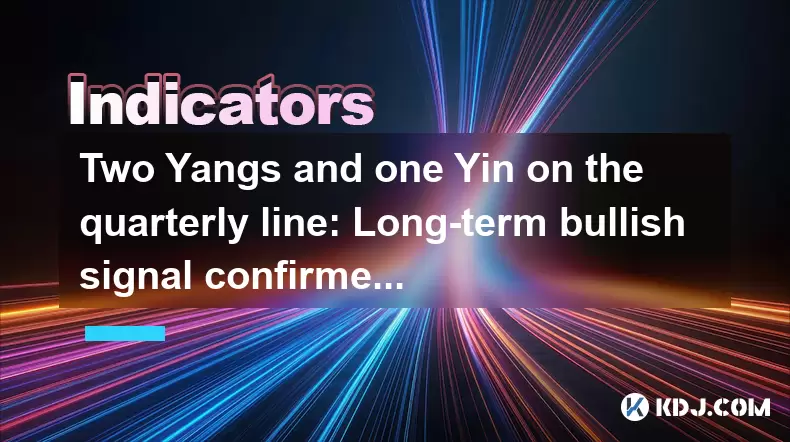
Two Yangs and one Yin on the quarterly line: Long-term bullish signal confirmed?
Jun 12,2025 at 07:00am
Understanding the 'Two Yangs and One Yin' Candlestick PatternIn technical analysis, candlestick patterns play a pivotal role in identifying potential market reversals or continuations. The 'Two Yangs and One Yin' pattern is one such formation that traders often observe on longer timeframes like the quarterly chart. This pattern consists of two bullish (...
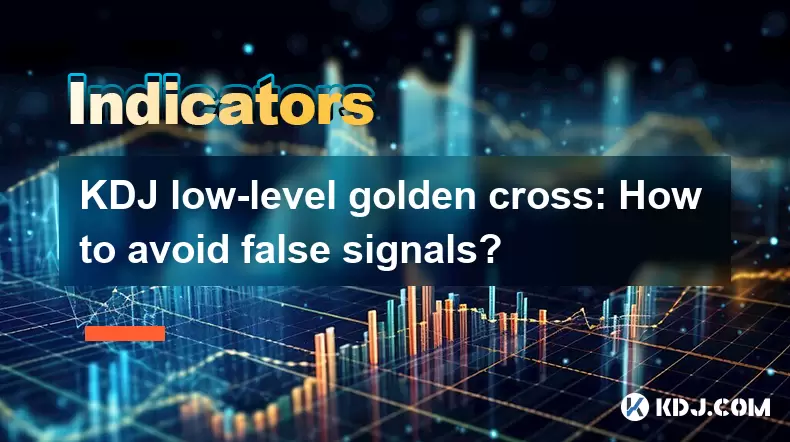
KDJ low-level golden cross: How to avoid false signals?
Jun 12,2025 at 08:21am
Understanding the KDJ IndicatorThe KDJ indicator, also known as the stochastic oscillator, is a momentum-based technical analysis tool widely used in cryptocurrency trading. It consists of three lines: the %K line (fast stochastic), the %D line (slow stochastic), and the %J line (divergence value). These lines oscillate between 0 and 100, helping trader...

Bottom-up volume stagnation: Is it accumulation or heavy selling pressure?
Jun 12,2025 at 01:42pm
What Is Bottom-Up Volume Stagnation?Bottom-up volume stagnation refers to a specific pattern observed in cryptocurrency trading charts where the price of an asset moves sideways or slightly downward, and trading volume remains consistently low over an extended period. This phenomenon is often seen after a sharp price drop or during a prolonged bear mark...
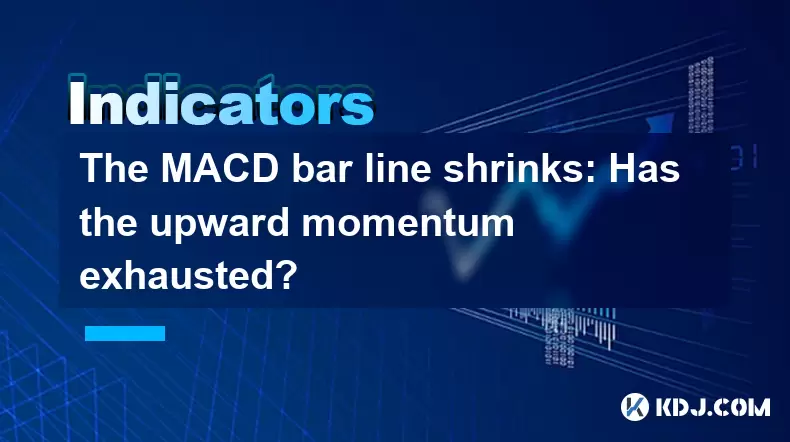
The MACD bar line shrinks: Has the upward momentum exhausted?
Jun 12,2025 at 12:49am
Understanding the MACD Bar LineThe Moving Average Convergence Divergence (MACD) is a widely used technical indicator in cryptocurrency trading. It consists of three main components: the MACD line, the signal line, and the MACD histogram (also known as the bar line). The MACD bar line represents the difference between the MACD line and the signal line. W...

The chip peak moves up: Is the main force quietly shipping?
Jun 12,2025 at 01:01am
Understanding the Chip Peak Movement in Cryptocurrency MiningIn recent years, the chip peak movement has become a critical topic within the cryptocurrency mining community. This phrase typically refers to the point at which mining hardware reaches its maximum efficiency and output capacity. When this peak shifts upward, it often signals changes in the s...
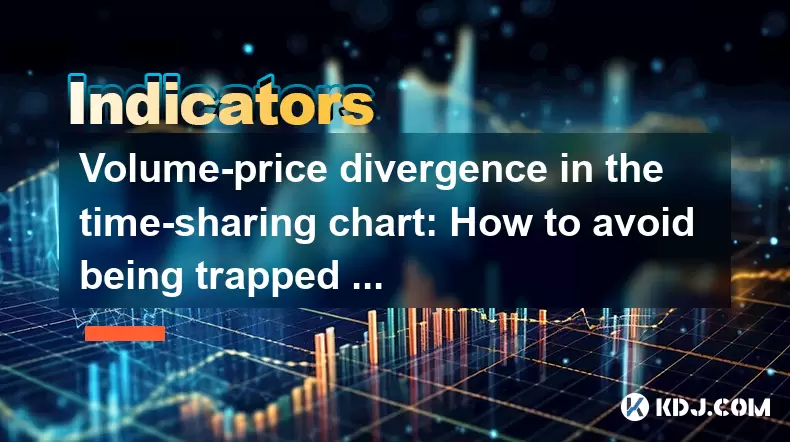
Volume-price divergence in the time-sharing chart: How to avoid being trapped on the same day?
Jun 12,2025 at 07:28pm
Understanding Volume-Price Divergence in Cryptocurrency TradingVolume-price divergence is a critical concept in technical analysis, especially within the fast-moving world of cryptocurrency trading. It refers to a situation where price movement and trading volume move in opposite directions. For instance, if the price of a cryptocurrency is rising while...

Two Yangs and one Yin on the quarterly line: Long-term bullish signal confirmed?
Jun 12,2025 at 07:00am
Understanding the 'Two Yangs and One Yin' Candlestick PatternIn technical analysis, candlestick patterns play a pivotal role in identifying potential market reversals or continuations. The 'Two Yangs and One Yin' pattern is one such formation that traders often observe on longer timeframes like the quarterly chart. This pattern consists of two bullish (...

KDJ low-level golden cross: How to avoid false signals?
Jun 12,2025 at 08:21am
Understanding the KDJ IndicatorThe KDJ indicator, also known as the stochastic oscillator, is a momentum-based technical analysis tool widely used in cryptocurrency trading. It consists of three lines: the %K line (fast stochastic), the %D line (slow stochastic), and the %J line (divergence value). These lines oscillate between 0 and 100, helping trader...

Bottom-up volume stagnation: Is it accumulation or heavy selling pressure?
Jun 12,2025 at 01:42pm
What Is Bottom-Up Volume Stagnation?Bottom-up volume stagnation refers to a specific pattern observed in cryptocurrency trading charts where the price of an asset moves sideways or slightly downward, and trading volume remains consistently low over an extended period. This phenomenon is often seen after a sharp price drop or during a prolonged bear mark...

The MACD bar line shrinks: Has the upward momentum exhausted?
Jun 12,2025 at 12:49am
Understanding the MACD Bar LineThe Moving Average Convergence Divergence (MACD) is a widely used technical indicator in cryptocurrency trading. It consists of three main components: the MACD line, the signal line, and the MACD histogram (also known as the bar line). The MACD bar line represents the difference between the MACD line and the signal line. W...

The chip peak moves up: Is the main force quietly shipping?
Jun 12,2025 at 01:01am
Understanding the Chip Peak Movement in Cryptocurrency MiningIn recent years, the chip peak movement has become a critical topic within the cryptocurrency mining community. This phrase typically refers to the point at which mining hardware reaches its maximum efficiency and output capacity. When this peak shifts upward, it often signals changes in the s...

Volume-price divergence in the time-sharing chart: How to avoid being trapped on the same day?
Jun 12,2025 at 07:28pm
Understanding Volume-Price Divergence in Cryptocurrency TradingVolume-price divergence is a critical concept in technical analysis, especially within the fast-moving world of cryptocurrency trading. It refers to a situation where price movement and trading volume move in opposite directions. For instance, if the price of a cryptocurrency is rising while...
See all articles





















